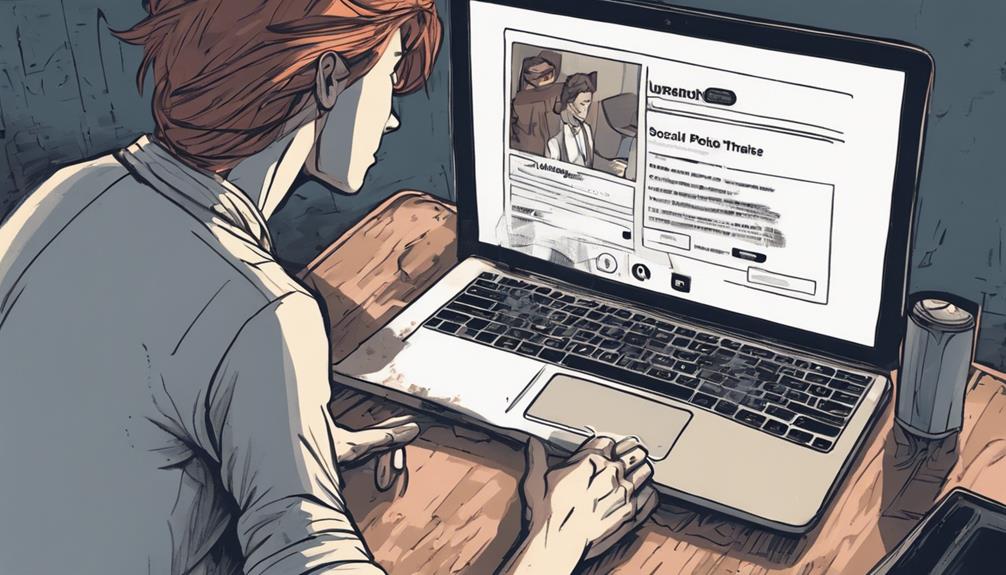In the intricate web of female relationships, deciphering signs of intimidation and threat can be like navigating a labyrinth of emotions and subtleties.
Subtle cues and behaviors can speak volumes about underlying sentiments that may not always be overtly expressed. As we observe interactions among women, certain indicators may surface, hinting at deeper feelings of insecurity or competition.
By being attuned to these nuances, we can gain insight into the complexities of female dynamics and perhaps uncover hidden layers of interactions that go beyond what meets the eye.
Key Takeaways
- Avoidance of conversation or presence, closed-off body language, and passive-aggressive behavior indicate feeling threatened.
- Negative reactions like celebrating failures and boasting excessively may signal insecurity and intimidation.
- Competitive behavior, such as trying to steal the spotlight or imitating you, can show a sense of threat.
- Passive-aggressive, undermining, attention-seeking, and challenging behaviors may signify feeling intimidated or threatened.
Behavioral Indicators of Intimidation
When faced with signs of threatened behavior, individuals may exhibit various behavioral indicators of intimidation that can manifest as avoidance of conversation, closed-off body language, and engagement in passive-aggressive behavior.
It's important to recognize these signals as potential responses to feeling intimidated, as they can provide insight into the emotional state of the individual.
Avoidance of conversation about personal matters could indicate a sense of vulnerability or discomfort. Closed-off body language, such as crossed arms or avoiding eye contact, might signal defensiveness or unease.
Additionally, engaging in passive-aggressive behavior, like subtle insults or backhanded compliments, could be a way for someone to express their insecurity or frustration indirectly.
Understanding and empathizing with these behaviors can help foster better communication and relationships.
Negative Reactions

After observing behavioral indicators of intimidation, recognizing negative reactions becomes crucial in understanding and addressing potential threats in interpersonal interactions.
- Celebrating your failures
- Two-faced behavior
- Boasting excessively
When negative reactions such as celebrating your failures, displaying two-faced behavior, or boasting excessively arise, it may indicate a sense of insecurity or jealousy in the other person. These behaviors can be subtle yet revealing, showing a lack of genuine support or a desire to undermine your achievements.
Competitive Behavior
In interpersonal interactions, competitive behavior can manifest through actions aimed at stealing the spotlight or seeking attention in ways that challenge and potentially undermine others. It's essential to recognize these behaviors as they can affect our relationships and well-being. When someone engages in competitive behavior, they may be trying to assert their dominance or feel threatened by your success. Here is a breakdown of signs to look out for:
| Signs of Competitive Behavior | Description |
|---|---|
| Trying to steal your spotlight | Seeking attention excessively |
| Trying to be like you | Antagonizing you on social media |
| Constantly seeking attention | Competing for visibility |
Being aware of these signs can help navigate tricky social dynamics and maintain healthy boundaries.
Passive-Aggressive Behavior

Passive-aggressive behavior often masks underlying feelings of resentment and manifests in indirect expressions of hostility or resistance. When dealing with passive-aggressive behavior, it's essential to recognize the subtle signs that may indicate someone is feeling threatened or insecure.
Here are some key indicators to watch out for:
- Consistently making excuses instead of directly addressing issues
- Using sarcasm or backhanded compliments to convey negative feelings
- Procrastinating or purposely performing tasks poorly to express frustration
These behaviors can create tension and misunderstanding in relationships. By acknowledging and addressing passive-aggressive tendencies, we can work towards fostering healthier communication and resolving conflicts more effectively.
Undermining Behavior
Undermining behavior can erode trust and create toxic dynamics within relationships, manifesting in subtle yet damaging actions that diminish one's credibility and self-esteem. It can be challenging to identify undermining behavior as it often occurs behind the scenes, leaving a trail of doubt and insecurity. Here are some signs to watch out for:
| Signs of Undermining Behavior | ||
|---|---|---|
| Sharing Your Struggles with Others | Adding Negative Opinions to Your Stories | Gossiping Behind Your Back |
| Denying Spreading Rumors | Betraying Your Trust | Making You Doubt Yourself |
| Diminishing Your Accomplishments | Questioning Your Abilities | Discrediting Your Efforts |
Being aware of these behaviors can help you navigate relationships with a clearer understanding of potential threats.
Attention-Seeking Behavior

When observing individuals who exhibit attention-seeking behavior, it becomes evident how their actions and demeanor strive to draw focus towards themselves in various social settings. This behavior can manifest in multiple ways, including:
- Constant boasting
- Attempting to outshine your accomplishments
- Exaggerating personal achievements
Individuals engaging in attention-seeking behavior may seek validation, recognition, or admiration from others. Their actions can sometimes come across as overwhelming or insincere, but it's essential to understand the underlying reasons for their behavior.
Challenging Behavior

Observing individuals who exhibit attention-seeking behavior can provide insights into their underlying motives and how their actions impact social dynamics, leading to a deeper understanding of challenging behavior. When faced with challenging behavior, it's essential to recognize the signs and navigate the situation with empathy and understanding. Here is a table highlighting key indicators of challenging behavior:
| Signs of Challenging Behavior | Description | Impact on Relationships |
|---|---|---|
| Constantly challenging you in public | Engaging in confrontations in public settings | Creates tension and discomfort |
| Manipulating group dynamics against you | Influencing group opinions to your detriment | Undermines your position within the group |
| Bringing up embarrassing past events | Delving into past mistakes or incidents | Causes embarrassment and discomfort |
| Seeking to embarrass you | Intentionally trying to humiliate you | Damages your self-esteem and reputation |
Imitation Behavior

Imitation behavior can offer valuable insights into individuals' desires and motivations, shedding light on how they seek to emulate and replicate certain aspects of another person's character or style. When someone imitates you, it can reveal a deep admiration or envy towards you. This behavior often stems from a desire to embody qualities they perceive as positive or desirable in you. It can also indicate a longing for the confidence and charisma you possess.
Understanding imitation behavior can help navigate complex social dynamics and foster deeper connections with others.
- Imitating your style and behavior
- Copying your choices and preferences
- Mimicking your personality
Online Behavior

As we shift our focus to Online Behavior, it becomes evident how individuals utilize digital platforms to express their reactions and sentiments towards others. Online spaces have become avenues for both positive and negative interactions, often reflecting underlying feelings of intimidation. Criticizing your online presence, disapproving of your actions, finding fault with everything you do, expressing hostility through social platforms, and undermining you through online interactions are all signs that someone may feel threatened by you.
These behaviors can manifest as passive-aggressive comments, public antagonizing, or even attempts to make you look foolish online. Understanding these online behaviors is crucial in identifying potential threats and navigating digital environments with awareness and caution.
Frequently Asked Questions
How Can One Effectively Confront Someone Who Is Displaying Passive-Aggressive Behavior Towards Them?
When confronting passive-aggressive behavior, we address the issue directly, fostering open communication. We express our feelings calmly and assertively, encouraging honest dialogue. By setting boundaries and seeking mutual understanding, we navigate conflicts constructively, promoting healthy relationships.
What Are Some Strategies for Dealing With Individuals Who Constantly Seek Attention and Try to Outshine Others?
When dealing with attention-seeking individuals seeking to outshine others, we prioritize setting clear boundaries, focusing on our accomplishments, and maintaining authenticity. By staying true to ourselves, we can navigate these situations with grace.
How Can One Address a Situation Where Someone Is Imitating Their Style and Behavior in a Way That Feels Uncomfortable?
Addressing discomfort from someone imitating your style involves setting boundaries kindly but firmly. Express how their actions make you feel and emphasize the importance of individuality. Encourage open communication to prevent misunderstandings and preserve personal authenticity.
What Steps Can Be Taken to Handle Online Criticism and Hostility From Others Who Are Threatened by Your Presence?
Handling online criticism and hostility requires resilience. We should engage thoughtfully, address concerns respectfully, and prioritize self-care. By focusing on positive interactions, setting boundaries, and seeking support, we can navigate these challenges with grace and strength.
How Can One Navigate a Situation Where Someone Is Constantly Challenging Them in Public and Seeking to Embarrass Them?
Navigating public challenges and embarrassment requires grace and assertiveness. Addressing issues calmly and setting boundaries firmly can defuse tension. Remember, staying true to yourself is crucial in such situations. Confidence and self-assuredness are key.
Conclusion
As we navigate the intricate web of female relationships, it's crucial to be attuned to the signs of intimidation and threat. By recognizing the subtle behaviors and indicators discussed in this article, we can approach our interactions with a deeper understanding and empathy.
Let's continue to observe, reflect, and engage with one another with sensitivity and compassion, fostering a culture of support and empowerment among women. Stay vigilant, stay connected, and stay empowered.









